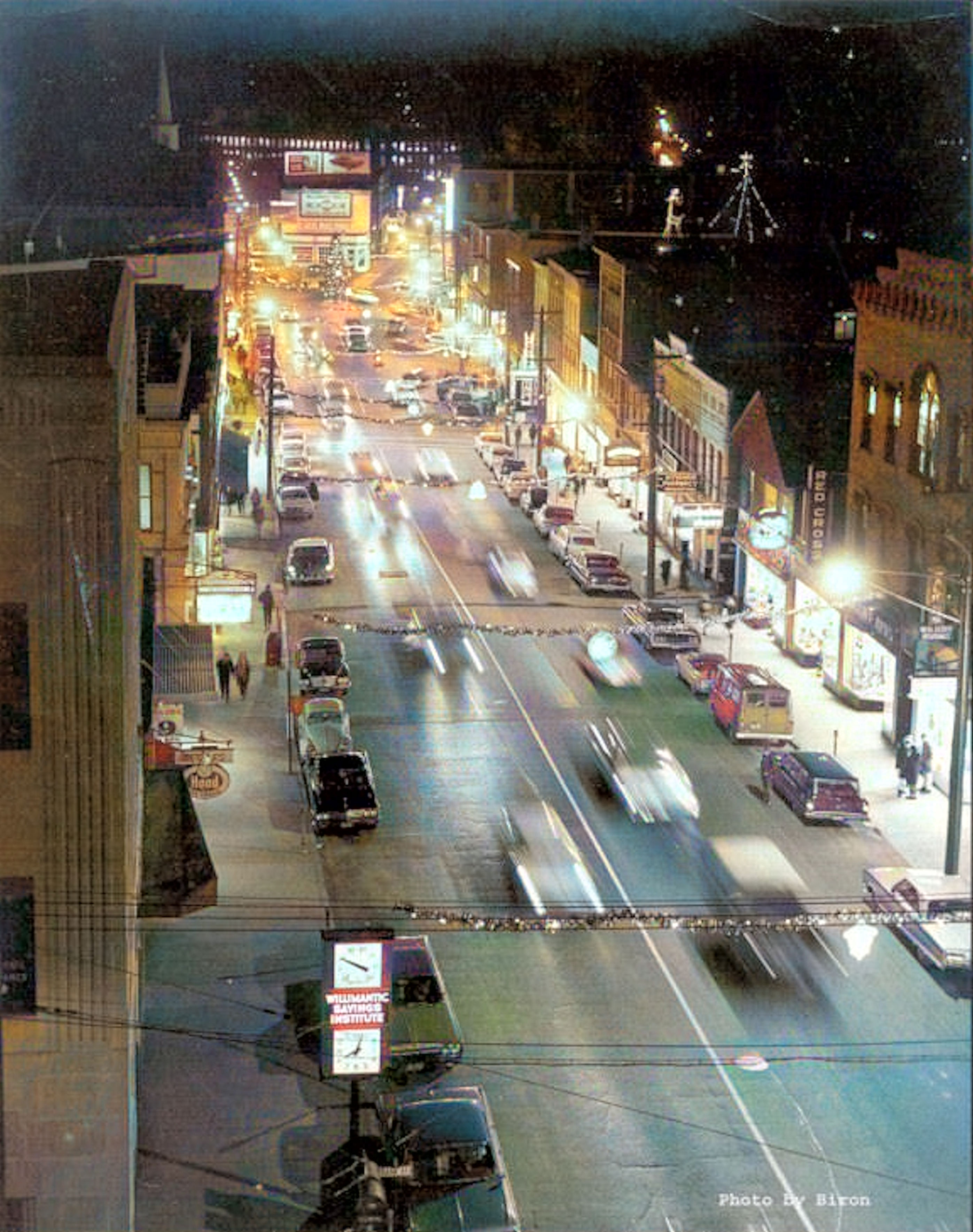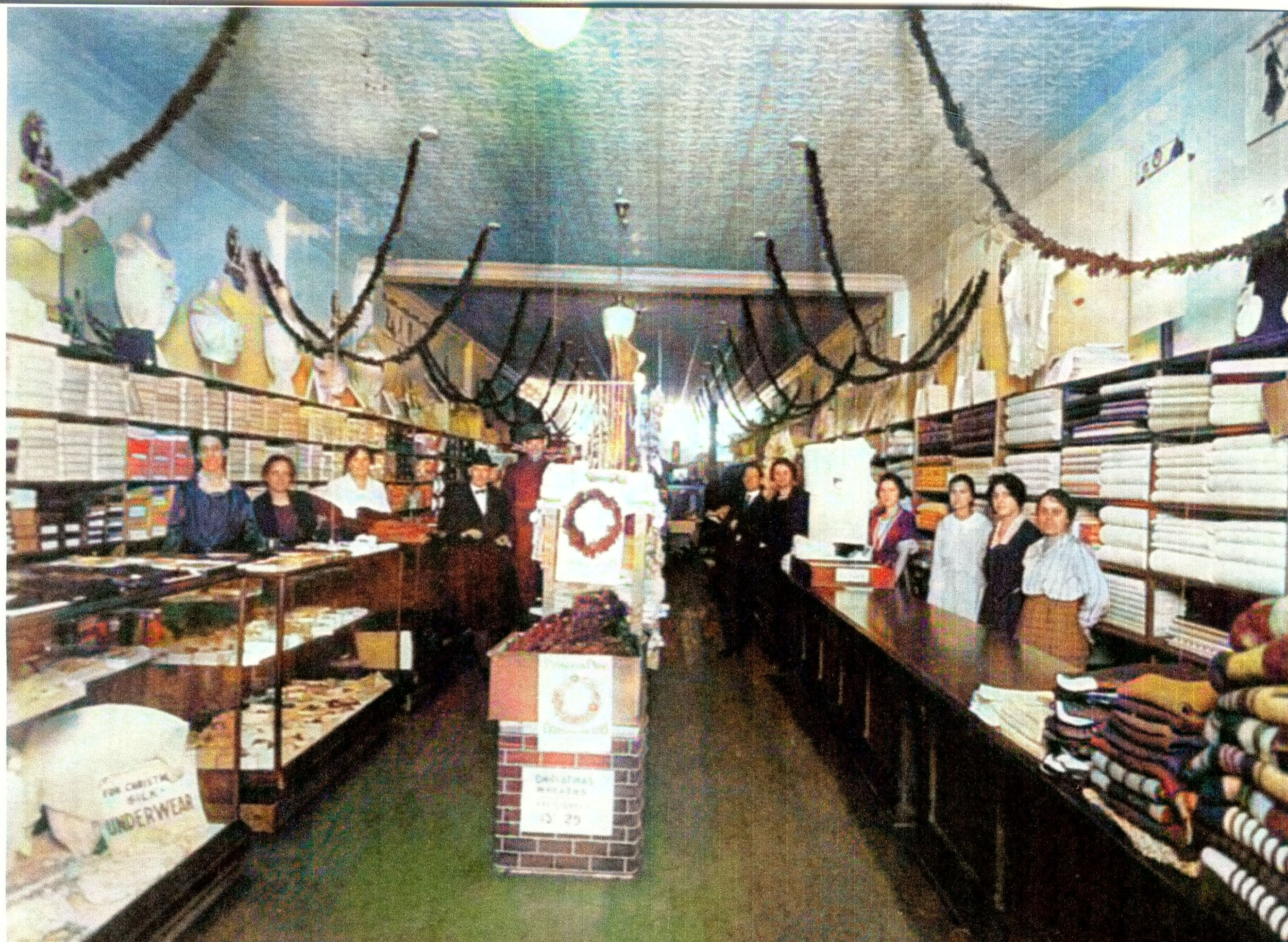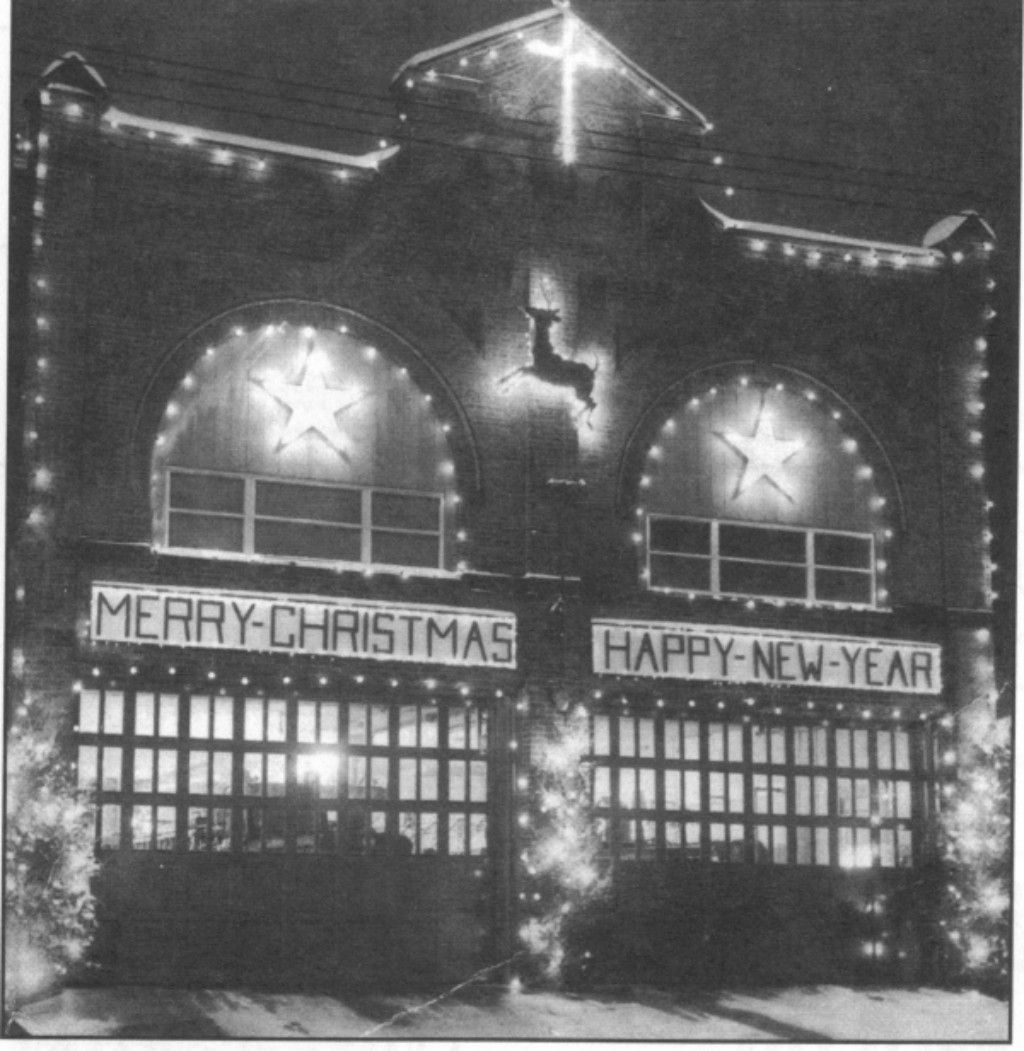by Pete Zizka
12-24-2020
Christmases Past
I reviewed newspaper articles back through
1900 for material on Christmases past in town. From 1900 through 1950,
many of the same themes appeared almost annually. First, the great sales
experienced by businessmen. In 1901, a Christmas Eve article said that
“the Christmas trade will break all previous records. An interesting
note in the 1910 coverage was that, “upwards of $1,500 in gold was drawn
from local banks for use as Christmas presents”. The second theme was
the rush to send Christmas cards and packages. The 1901 article mentions
that,” never in the history of the local post office has there been so
great a volume of business and the incoming mails today are expected to
tax the capacity of the office employees and carriers to the extent of
their ability”. In 1910, “over 25,000 one cent stamps were sold during
the week prior to Christmas”. The two local express companies also said
that business had increased and that they had been “rushing” for over a
week. The third theme was that passenger traffic increased significantly
on the train lines that ran through the city. For several years, the
reports were that passenger traffic on the railroads was exceptionally
heavy and that most of the trains had to supply extra cars. And, even
back in the first part of the 1900s the extra traffic meant extra
problems in the form of breakdowns and delays.
by Pete Zizka
“Christmas is near at hand, and everybody is busy preparing for the
world wide holiday of the year. The Sunday school is especially busy
preparing for a Christmas tree and its accompanying festivities. The
(North Windham) school is being very generously aided by the villagers
generally and no doubt Monday evening next will prove a pleasant and
profitable one to all who may attend. The children give recitations, and
the singing led by the superintendent W.C. Burdick is always fine and
spirited. It is hoped that our resident jubilee singers may again favor
us at that time, with some of their sweet melodies. All are welcome.”
(From “The Chronicle”, 1882).
by Pete Zizka
12-24-2022
This Christmas Eve, we’ll take our yearly look back to the happenings of Christmas weeks of the past. On Christmas Eve in 1892, “severe cold weather dominated the area. The Windham Cotton Company‘s section of the Willimantic River was frozen solid, much to the glee of local skaters, who sped down its mile long length. The area was "thickly covered with young people of both sexes every morning and afternoon." The low temperatures also caused cracks in the town's gas mains. A large crack in the main situated under the corner of Church and Valley Streets caused a dangerous leak. The gas could find no way out of the frozen ground and consequently made its way into the lower stories of the Holland and Natchaug Silk Company's mills, causing them to be evacuated of workers. The cold, it was reported, “forced its way through every crack and crevice” and caused great damage to water and steam pipes and , “ruffled the tempers of good housewives”. The post office was affected due to the fact that someone had left the windows open slightly and so it was nearly noon before the building was heated enough for workers to go about their jobs. The Chronicle mentioned that, “the country people looked more after their comfort than pleasure and sat by their fires at home rather than drive to town for ‘Christmas fixings’”. And even if they had, there was not much to be seen since the display windows of all the stores were so frosted up that the “fine display of Christmas goods was hidden from view by a thick curtain of frost”. Some merchants placed oil lamps in the windows but they only thawed an area “about the size of a dining plate”. In 1917, Christmas in Willimantic passed quietly. On Christmas Eve, plans had been made for a “Community Christmas Tree”. The exercises were held at the “Elms” on the corner of Main and Beech Streets. A forty-foot tree had been positioned on the east lawn of the Elms and was wired with hundreds of electric lights. A children’s chorus, under the direction of Mrs. Amelia Damon, had been rehearsing Christmas carols. At the celebration, they gathered around the tree singing carols and then marched through lower Main and Ives Streets. A bright and cold Christmas Day greeted worshipers at five masses at St. Mary's the four masses at St. ]oseph's and the services at all the local churches. It was a busy day for the railroads and the trolley cars, which deposited visiting relatives in town from outlying areas. Willimantic's three movie houses were packed for each performance, and a Christmas Day dance at the town hall attracted over 200 people, who waltzed to the music of Pickett's orchestra. The 29 inmates at the town almshouse were treated to a roast pork dinner. Superintendent Slater presented each man with cigars and candy, and Mrs. Clinton, the matron, each of the women with two handkerchiefs and a box of candy. And to round out this quiet Christmas, the police reported no arrests. In 1942, the Textile Workers‘ Union of America, sponsored a children’s party in the Capitol Theater. They had a Santa Claus and organized games and handed out packages of candy and refreshments to the children, all aged between 7 and 14. The party was considered to be a great success, and the C.l.O. announced that from now it would be an annual event. The Electro-Motive Manufacturing Company held a Christmas tree party at the plant. Employee bonuses were determined by each individual’s period of employment at the plant. The minimum payout was $10. Company President Philip Lauter announced that everyone was invited to Electro Motive’s annual holiday party. Each employee was urged to bring a friend to enjoy a “high grade floor show, dancing refreshment and novelties." In 1967, heavy snow on December 23 ensured that it would be a White Christmas in Willimantic. The storm deposited five inches of the white stuff onto the city streets, beginning at 2AM. Public Works Superintendent Alexis Caisse announced that plowing, sanding and salting commenced at 3:30 AM, but there was still a large number of minor auto accidents during the early morning. The snow did not bother employees of Electro- Motive. They had just received their generous, yearly Christmas bonus. It was calculated that nationwide, Electro-Motive's 1,600 employees had received an extra $298,000 to help them celebrate Christmas. Visit threadcity.us for more photos and articles. This week's pic was taken by Armand Biron in 1963 and is used with his permission.

Click on photo for larger version
by Pete Zizka
12-23-2023
At the very beginning of the 20th century, more and more editorials decried that Christmas was becoming to “commercialized”. In the first couple of decades, though, the editorials were critical of individuals who were more interested in the cost of the gifts than the spirit behind them. Then, an editorial in 1911 said, ”Christmas in the good old days used to be a season of celebration and generosity….Today it is a gift-giving enterprise….The Christmas festival is celebrated everywhere but its highest expression is seen in the department store”. A 1913 article in “Biblical World” mentioned the anxiety of gift giving “lest we give someone a present of less (or more) value than the present someone has given us”. But then the article asked readers to focus on the fact that, “even the most commercialized of us want to make someone else happy. We actually are ready to give something to make this happiness secure”. In Willimantic, however, “commercialization” didn’t seem to be a problem. Shopping Main Street, filled with other shoppers and small stores whose owners and employees were local folks, was a true joy. The generosity and Christmas spirit exhibited by local merchants was felt by all. A good example is this one. In the 1920s and ‘30s, Frank P. Lombardo‘s fruit and vegetable store was at 763 Main Street. One of Frank’s sons recalled how generous his father was to those less fortunate. “The store was located next to an alley. At Christmas time my father would go to the tree farms and purchase hundreds of Christmas trees. He would have them placed in the alley next to the building. During the night time, the youngsters from the poorer families would raid the valley and get a nice Christmas tree to brighten up their homes for the holiday. Many would tell my father the trees were being stolen but he would just smile and say, ‘They need a tree for Christmas.’ Of course, he always had his mental calculator operating so he knew how many trees he could afford to have stolen and still make a profit.” In the 1960s, Willimantic’s older residents fondly remembered Christmas shopping in the 1920s and ‘30s. “On a Saturday afternoon it would take two or three hours just to walk from Church Street to Bank Street. We chatted with the people on the street, and stopped in the shops to pass the time. No one would think of passing by Hurley's without stopping in to visit with Edmund and Verna Hurley and later the three boys, George Fraser, Earl McSweency, and Arthur Loiselle. The shops were open on Christmas Eve and everyone was downtown doing their last minute shopping and kissing their Willimantic neighbors for a Merry Christmas.” That is what shopping was like before the advent of super stores and markets. In 1967, First Selectman Ralph Crosthwaite issued holiday greetings to the residents of the Windham-Willimantic area. He said, “As we approach this festive holiday, I want to sincerely wish each and every citizen a most joyous Christmas ever mindful that this feeling of goodwill is in commemoration of the birth of the Christ Child. We have, indeed, many things to be thankful and joyful about this year. Our citizens are enjoying peace, prosperity and good health. All these things make for better living and a happier community.” The Christmas shopping rush was in “full swing” in downtown Willimantic, and it looked as if 1967 would be a record-breaking Christmas for local businesses. Opening hours were extended for one week until December 23, with stores staying open until 9 p.m. every night. John Wrana, director of the Willimantic Chamber of Commerce, urged shoppers to, “Try Willimantic First.” These were the days when Willimantic boasted five rnen’s shops, two sporting goods stores, seven shoe stores, seven women’s shops, six department stores, four hardware stores and a wide variety of eating places. Mayor Kokoska said that all city parking would be free until Christmas and Police Chief Martin Viullermet announced that he was organizing extra patrols to help out of town shoppers find parking lots. The heavy snow on Dec. 23 ensured a white Christmas in Willimantic. This week’s photo shows the interior of the Fullerton Fournier clothing store decorated for Christmas. The women’s clothing store was started by James Fullerton in the early 1900s. In 1934, Albert Fournier, who had bought the store previously, reorganized the store and incorporated it as Fullerton-Fournier.

Click photo to see larger version
Link to THREADCITY.US HOME PAGE

